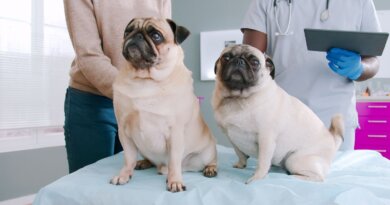Socialization and Behavioral Issues – Dogster
You may have heard dogs born in 2020 called pandemic puppies or dogs. These dogs developed behavioral issues related to growing up on lockdown. If this describes your dog, he may need help navigating a world outside COVID lockdown, since he did not get to socialize with other dogs during that important formative time. This resulted in adult dogs who struggle with socialization, overreactivity and separation-related issues.
What is a pandemic dog?
Commonly known as “pandemic puppies,” these young dogs were brought into homes during the height of the pandemic and beyond. Similar to the groupings of a human generation label (i.e., Gen X or Gen Z), the timeline of pandemic puppies is a bit fuzzy but generally considered to be between March and December 2020.
According to Frontiers in Veterinary Science, online searches for both cats and dogs topped out in April and May of 2020, for dogs this began to decrease in July and returned to average (compared with 2019) by the end of 2020. The ASPCA estimates 1 in 5 households adopted either a cat or dog during spring and winter of 2020 and 90% of these dogs remain in those homes.
Pandemic dogs socialization issues
Generation P’s biggest problems stem from lack of proper socialization. Right alongside us, pandemic puppies lived very sheltered lives for a year or longer. Therefore, they didn’t get the necessary exposure and experiences to help navigate new situations confidently.
Socialization remains one of the simplest yet most complex components of dog behavior — it’s also arguably the most important. In short, canine socialization is the process of acclimating dogs to live comfortably with other humans and dogs, places, objects and activities.
Dogs have very definitive points in their development where socialization takes place. The general estimate for this developmental window is between 3 to 16 weeks where dogs’ brains are the most receptive to novelty. Proper socialization involves distinctly positive experiences, or potentially negative experiences turned into positive experiences. In short, no negative experiences and a wealth of stellar ones. But Generation P’s flat-out lack of many of these experiences has led to fear and anxiety when faced with newness.
So how do you expose your fearful dog to new things? Don’t throw your dog into the deep end of the pool! Be her emotional support human and hold her paw while she learns to navigate new things in life, whether it’s meeting new dogs, people or experiencing new things. Always work to create positive associations and set her up for success.
Pandemic dog socialization do’s
- Take it slow and do not overwhelm. One new thing at a time.
- Brush up on dog body language so you know if your dog’s feeling it or not.
- Always allow your dog the choice to opt out of anything at any time.
- Go at her pace — never force her.
- Don’t lead (or drag!) her to any new thing or situation. Allow her to approach if/when she’s ready.
- Give her time and space to figure things out.
- Support her choices. Praise, play and treats help make positive associations
Pandemic dog socialization don’ts
- Never force interactions.
- Don’t break trust by forcing it. Always be willing to let it go and let her opt out.
- Never scold or otherwise punish your dog for her reactions to new things and risk making it worse or breaking trust.
- Avoid trying to do too much at once or too much too soon. One experience/dog/human/activity at a time!
- Dogs are always communicating, so don’t ignore her efforts to tell you how she’s feeling about any given situation.
Finally, take time to consider whether what you’re asking of your dog is truly necessary. For example, most dogs actually don’t want to be social butterflies once they depart puppydom. Focus on what helps your dog and family feel the most comfortable and at ease and start there. So, if separation-related issues are the top priority, hone in on that first and table the other issues for now. Working together and making improvements is sustainable for the long haul.
How to socialize a pandemic dog with other dogs
Although you can’t “redo” socialization, you can help to minimize your dog’s overreactivity, stress and fear.
Don’t force the issue or allow your dog to rehearse, or practice, undesirable behavior:
- barking
- lunging
- growling
- snapping
- biting
Distance is your BFF when looking to expose your dog to other dogs in a positive way. Follow these dog dog socialization steps:
- Choose neutral territory that’s safely contained.
- Minimize most (ideally all) distractions.
- Start with dogs on short leashes from as far away as necessary where your dog is interested, but not overreacting.
- Carefully gauge body language as you slowly decrease the space between them.
- If either dog shows signs of stress, stop and retreat.
- Try again if dogs are calm.
- If not, try a different day or a different dog.
- If all is well, drop the leashes, but keep them on a bit in case you need to act quickly.
- Keep interactions short and sweet. End on positive note.
If your dog can’t handle being in an enclosed space with another dog without being overreactive, call in a pro for help with proper desensitization techniques.
Pandemic dogs: separation-related Issues
We all got used to hanging out with each other, and only each other, for many months, and in some cases well over a year. So, when people with pets began returning to work (or worked from home but returned to socializing themselves), our puppies-turned-adolescents were left alone for the first time in well, forever. Even adult dogs and resident dogs pre-COVID were used to us being home with them 24/7. Then we weren’t.
As many of us returned to more normal lives after lockdown, our dogs were simply left alone. As a result, many of these dogs developed separation-related behaviors such as:
- Barking or howling
- Inappropriate chewing
- House soiling
- Panting, pacing, drooling
- Destructive behaviors
These behaviors may subside about 15 to 20 minutes after you leave, or things could be more serious and be full-blown separation anxiety. Separation anxiety for dogs is often used as a catch-all phrase for problems when dogs are left alone. However, true separation anxiety is a much more serious problem, which can be likened to a panic attack in humans. It likely needs the help of a professional trainer and even your vet, because medications may be part of the treatment plan.
Management strategies for separation-related issues include desensitizing your dog to your absence and teaching and reinforcing calm behaviors when you’re home. This includes while you’re getting ready to leave, which can often trigger dogs to the fact you’re about to leave. Follow these steps to help with dog separation-related issues at home:
- Be sure your dog gets enough physical and mental stimulation each day. You have hobbies, devices, friends, work, etc. Your dog only has you. Fill up her life with the good stuff so she’s content.
- Break up the day. Come home for lunch or arrange for someone to pay a visit for playtime and petting while you’re gone.
- Minimize disturbances. Close the blinds, leave the TV on. Prevent your dog from being stressed by outside things (unless your dog likes gazing out into the backyard or lying in beams of sunlight on the floor).
- There’s an app for that. Many apps help you monitor, talk to, treat and even interact with your dog while you’re away.
Dogs do not “get back at us” for leaving them or act out of spite or anger. Separation-related behaviors are usually directly related to the stress, anxiety and even fear your dog feels when you leave.
Pandemic dogs: When to bring in the pros
Getting knowledgeable and educated professionals on board with your dog’s care supplements any dog’s well-being. This is especially true for pandemic dogs.
If you suspect separation anxiety, consult with professionals. These professionals include a veterinarian, trainer, and pet sitter, as well as a Certified Separation Anxiety Trainer (CSAT).
Choosing an experienced, credentialed, rewards-based, force-free trainer makes all the difference. You can find one in your area by searching Pet Professional Guild (PPG) , Certification Council for Professional Dog Trainers (CCPDT) or the International Association of Animal Behavior Consultants (IAABC).
Visits to the veterinarian help your pandemic dog, especially if you can find a Fear Free Certified vet clinic. Fear Free Certified vet clinics and other Fear Free Certified professionals, such as trainers, groomers, dog walkers and now boarding facilities, are trained and required to maintain continuing education in helping alleviate stress, fear and anxiety that generally comes with these experiences. We all use at least one of these services, so this is a simple way to help support your dog’s emotional and behavioral health.
Your dog didn’t develop her issues overnight, and she won’t get over them overnight, either. It boils down to this: You both needed each other during the pandemic and while you love your dog, she probably needs you now more than ever. You may not have your Dream Dog but with support, patience and lots of love you can both be living the dream together.




